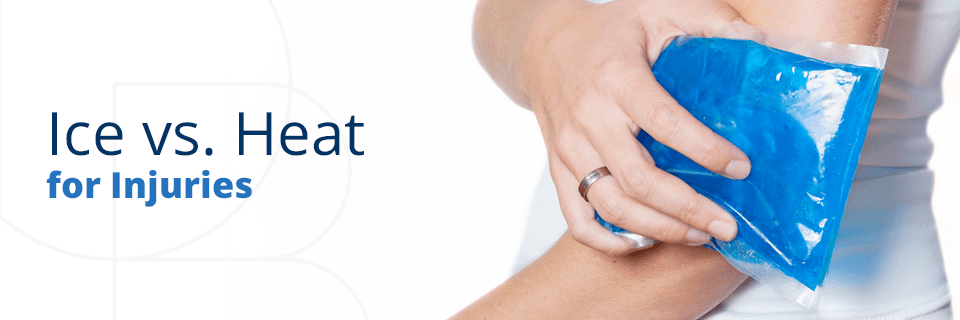
Quick Navigation
- What Ice Does to the Body
- When Ice Is the Answer
- When You Should Not Use Ice
- What Heat Does to the Body
- When Heat Is the Answer
- When You Should Not Use Heat
- When to Use Both Ice and Heat
- How to Use Ice
- How to Use Heat
- Pros and Cons of Ice
- Pros and Cons of Heat
- Contact OrthoBethesda
The human body is an incredible thing, but when you become injured, you may feel like your body is working against you. Whether you’re a full-time athlete, an office worker or a senior enjoying your retirement, injuries are an inevitable part of life. The good news is that, while you may feel like your body is causing you problems, it’s working hard to overcome the injury. That said, there are some ways you can help it along. In some cases, our bodies become overzealous about healing an injury, which can cause excessive swelling and pain.
So, how can you help an injury heal, all while keeping pain and inflammation down? Conventional wisdom says ice and heat can help accomplish these goals, but you may be asking yourself, “Should I use ice or heat for pain?” The answer depends on a few different factors, such as when you got injured, what type of pain you’re experiencing and more. In this post, we’ll talk about ice and heat, looking at how these two different types of therapy affect your body, when to use them and how to use them. We’ll finish with a pros and cons list for each method.
Whether you’ve experienced an injury or you want to prepare for the future, keep reading to learn more about the best ways to use ice and heat to treat pain and injuries.
What Ice Does to the Body
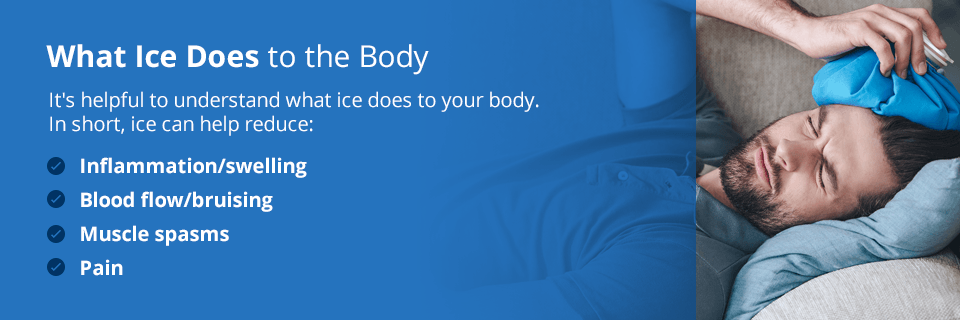
Before we look at when ice is the right way to treat an injury, it’s helpful to understand what ice does to your body. In short, ice can help reduce:
- Inflammation/swelling
- Blood flow/bruising
- Muscle spasms
- Pain
When you get injured, it’s natural for the site of the injury to become inflamed. Inflammation, which involves swelling of the tissue and blood vessels, is not necessarily a bad thing. It’s a natural part of healing and allows immune cells to better access the injured area. Though inflammation can be positive, to an extent, it can also get out of hand and cause debilitating swelling and pain. Ice reduces swelling and inflammation.
We’ll talk more about the potential adverse effects of ice in the pros and cons section, but it’s worth mentioning here that ice causes muscles to tighten, which may not always be what you want. If applied for too long, ice can also cause serious issues like frostbite.
When Ice Is the Answer

So, is it better to ice or heat an injury? In this section, let’s focus on times when it’s better to use ice.
- Acute injuries: In general, ice is best for acute injuries, which are injuries that affect a specific area on the body. An example of an acute injury is an ankle sprain, which will cause your ankle to become swollen and bruised, but shouldn’t directly affect other parts of your body.
- Recent injuries: Another clue that ice is best is if the injury happened relatively recently. Swelling tends to be the most extreme when you first become injured, especially within the first 48 hours.
- Overuse injuries: Athletes sometimes use ice to treat chronic inflammation in specific areas, such as a joint or muscle, from overuse. In these cases, you should only apply ice after and never before activity. If you have chronic conditions, don’t treat them with ice outside a doctor’s supervision.
Sometimes, an injury is unmistakable. You may feel your muscle tear, hear a pop in a joint or feel a sharp pain that indicates you’ve hurt yourself. When this happens, it’s usually smart to start icing right away. We’ll talk about how to do that later in this post. Even if you can’t pinpoint the moment of injury, if you just engaged in physical activity and now a specific area on your body is throbbing, you should operate under the assumption that you injured yourself and start icing the painful area.
When You Should Not Use Ice
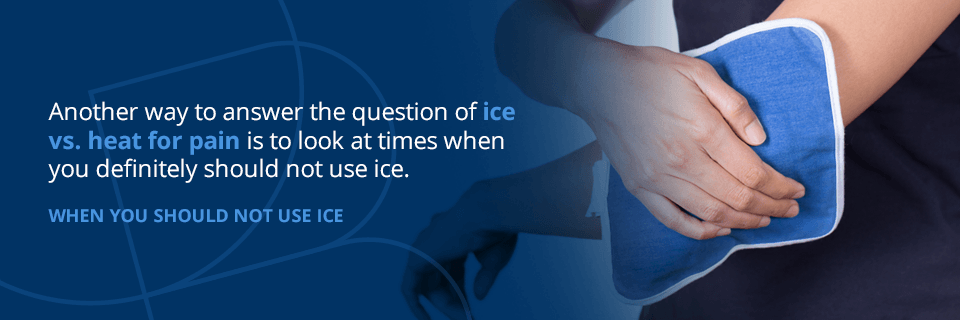
Another way to answer the question of ice vs. heat for pain is to look at times when you definitely should not use ice. In some of these cases, as we’ll see soon, heat is a much better choice. In other cases, you may need to refrain from any self-treatment. Here are a few instances when you should not apply ice to your body.
- If you have poor circulation: If you have a medical issue that limits your ability to feel sensations on your skin, such as diabetes, vasculitis or Raynaud disease, you should avoid ice or use it with extreme caution. That is because ice will damage your skin if you leave it on for too long, and this is all too easy to do when you can’t feel adequately.
- Before physical activity: If you are about to exercise, you should not use ice. For example, if your calf is hurting and you want to go for a run, you may be tempted to ice to get the swelling down and then hit the trail. That is a bad idea, because ice will cause the muscle to contract. You could cause further injury by icing and then exercising the muscle.
- On a tight muscle: If you’re in discomfort because your muscle is tight, icing is not the answer. Icing the muscle will cause it to contract even more. For example, if your neck or back feels tight or stiff, heat is a much better option for relaxing the muscles. Icing the area will likely do more harm than good.
- On an open wound: If your injury isn’t just internal but is also external, you should think twice before you apply ice. You shouldn’t place ice on an open wound or on skin that is burned or blistered. If your skin is compromised in any way, ask a doctor before you apply ice. If the doctor approves it, take special care to keep a barrier of some kind between the ice and your healing skin.
- If you have cold hypersensitivity: If you’re hypersensitive to cold, you should refrain from using ice. An example of cold hypersensitivity is cold-induced urticaria, which causes a person to break out in hives if exposed to cold. If you are hypersensitive to cold, it doesn’t mean you should automatically opt for heat instead. Read our sections on using heat to see if it’s the right solution.
What Heat Does to the Body
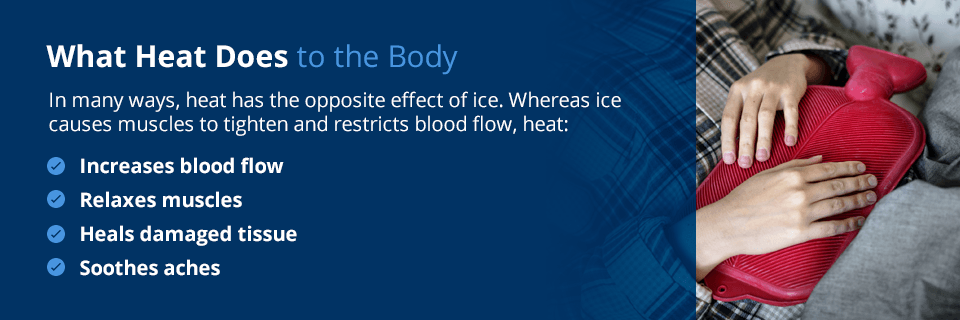
In many ways, heat has the opposite effect of ice. Whereas ice causes muscles to tighten and restricts blood flow, heat:
- Increases blood flow
- Relaxes muscles
- Heals damaged tissue
- Soothes aches
Many things can cause your muscles to become stiff and painful. For example, you may experience lower back pain after a day of moving heavy objects. Working or studying in a seated position can lead to neck pain. Whatever the cause, applying heat to the tight or achy area should have a soothing effect and cause the muscle to loosen.
When Heat Is the Answer

Seeing as ice and heat have such different effects on the body, it’s no wonder the two remedies are not interchangeable. So, when is heat the right choice for an injury? Here are some instances when heat is the best choice.
- Old injuries: Whereas ice is best to soothe new injuries, heat is typically best for nagging injuries that are still causing you pain. For example, if you pulled a muscle in your shoulder last month and you’re experiencing lingering discomfort, applying heat could help.
- Soreness or aches: In general, if you would describe your pain as soreness or an achy feeling rather than a throbbing or sharp pain, heat is an excellent option to bring you some relief. For example, arthritis patients may experience ongoing aches in their joints.
- Chronic muscle pain: If you have ongoing pain in a muscle, it’s likely because the muscle is tight and stiff. In these cases, heat may help relax the muscle. For example, if your job causes you to experience chronic pain in your lower back, you can treat it with heat.
- Overuse injuries: Overuse injuries are one instance both ice and heat have in common. However, you should use heat to treat an overuse injury before you plan to use the affected area. Then, use ice after the activity.
In general, heat is a better option for more minor aches and pains, as opposed to serious injuries. So, if you’re wondering, “Should I ice or heat an injury?” the answer is most likely ice. However, heat therapy is typically the best option if you’re not sure what’s causing your pain and it’s more of a general ache. As always, if you don’t know what to do, consult a doctor to learn more about the source of your pain and how you should treat it.
When You Should Not Use Heat
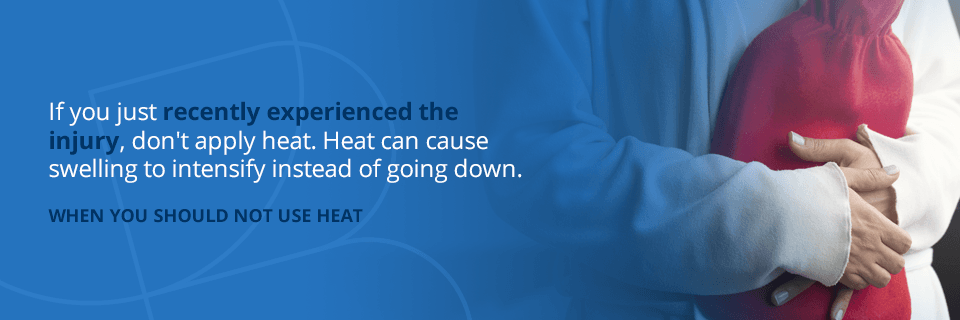
We just looked at some instances where heat is an effective form of treatment, but there are other times when heat therapy can do more harm than good. Let’s take a look at some instances when you should not use heat.
- On a fresh injury: If you just recently experienced the injury, don’t apply heat. Heat can cause swelling to intensify instead of going down. Ice is a much better choice for new, acute injuries.
- After physical activity: Heat can loosen up muscles before physical activity, but it’s never a good idea right after a workout. If you just exercised, and you’re experiencing pain, you may want to ice the affected area.
- On an open wound: This one goes for both ice and heat. If you have a cut, burn or another type of open wound on the skin, don’t apply heat to it. Ask a doctor how you should proceed and cautiously follow their instructions.
- If you get overheated: If you have an elevated body temperature due to a high fever or heat stress of some kind, you should not apply heat to any part of your body. When your body is already hot, adding more heat will not help.
- If you are pregnant: If you are pregnant, you can use heat to treat muscle aches in your back or other areas, but you should never apply heat directly to your abdomen. You should also refrain from full-body heat therapy, such as a sauna.
When to Use Both Ice and Heat

In some cases, ice and heat can work together to help relieve pain. Alternating ice and heat is called contrasting therapy, and it’s especially common for arthritis patients. Ice helps reduce swelling and acute pain, and heat helps soothe stiff joints. If you have arthritis, you should work with your doctor to develop a treatment plan to manage your discomfort.
Ice and heat can both come in handy for treating an acute injury, but you should use them at different stages. You can use ice initially to reduce swelling and then, once the injury has mostly healed, use heat to soothe any remaining feelings of soreness. For example, one-third of people who sprain an ankle experience residual symptoms even after the injury has healed. If the symptom is swelling, ice is still best, but if it’s a dull ache or stiffness, heat can help bring some relief.
If you have an overuse injury, which is common for athletes, both ice and heat can help you manage the pain and keep the injury from worsening. In the case of overuse, apply heat to the injury before your physical activity, then use ice on the area after the physical activity.
How to Use Ice
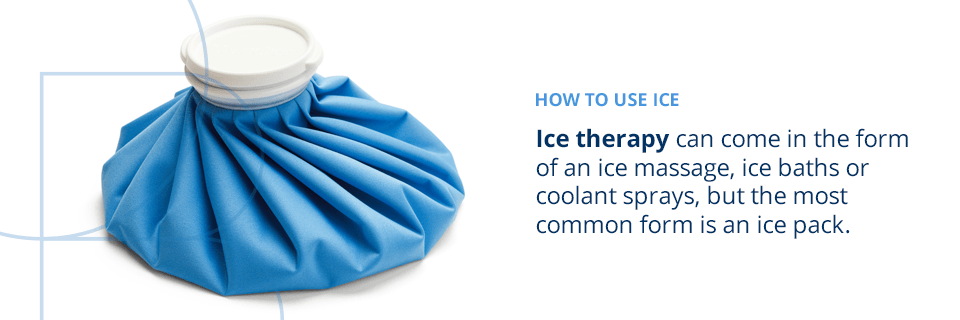
Now that you know when to use ice, let’s talk about how you should use it. Ice therapy can come in the form of an ice massage, ice baths or coolant sprays, but the most common form is an ice pack. Because people most often use ice to treat acute injuries, an ice pack is typically all you need to get the job done. You can make an ice pack by filling a bag with ice, or you can purchase reusable ice packs from the store.
Let’s look at a few essential do’s and don’ts when it comes to ice therapy.
Do:
- Wrap your ice pack in a towel or cloth to avoid direct contact with skin.
- Move your ice pack around every couple of minutes to avoid frostbite.
- Ice an injury multiple times a day.
- Use a flexible ice pack to wrap around ankles, shoulders or other rounded areas.
- Elevate the injured body part while you ice it.
Don’t:
- Allow ice to come into direct contact with skin.
- Leave ice on for longer than 20 or 30 minutes at a time.
- Ice your left shoulder if you have a heart condition.
- Ice the front or sides of your neck.
- Leave an ice pack on if your skin becomes red or bright pink.
Beyond these basic instructions, you should talk to your doctor about the best icing regimen for your injury. Some doctors may recommend a plan like 20 minutes on, 30 minutes off, meaning you should ice for 20 minutes, then wait another 30 minutes before icing again. A schedule like this would apply to a recent injury that is still swollen.
How to Use Heat
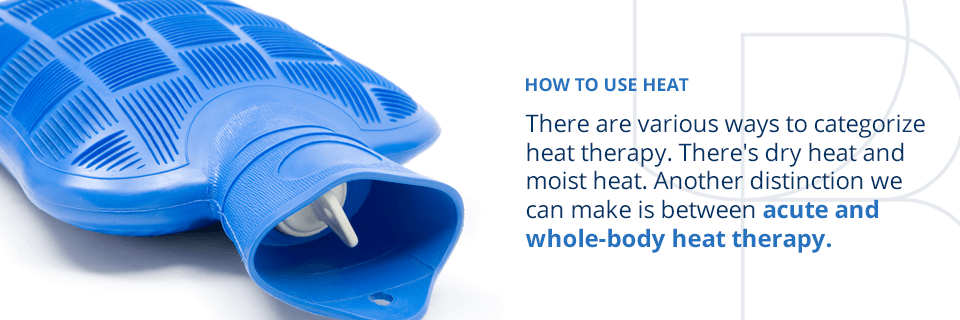
There are various ways to categorize heat therapy. For instance, there’s dry heat and moist heat. Another distinction we can make is between acute and whole-body heat therapy. For example, a heating pad is an example of dry heat for an acute injury, while a sauna is a whole-body dry heat method. A hot bath is an example of whole-body, moist heat therapy. If you wanted to treat an acute area with moist heat, you could use a damp, steaming towel.
So, how do you use these various forms of heat therapy? Here are a few basic do’s and don’ts.
Do:
- Use moderate heat that is not so hot that it causes discomfort or sweating.
- Use a heating pad or other localized method for acute pain.
- Use whole-body heat therapy for more widespread aches and pains.
- Use moist heat if you want it to penetrate deeper into your muscles.
- Pay attention to how your body responds to heat, since this can help you determine what the problem is.
Don’t:
- Use heat that is scalding and will burn your skin.
- Use localized heat for more than 15 or 20 minutes.
- Use whole-body heat therapy for more than two hours.
- Fall asleep on a heating pad.
- Continue to use heat if your pain worsens.
If you find you’re relying on heat to treat pain regularly, you should schedule an appointment with a doctor to talk about what might be causing the ongoing discomfort. Heat therapy may be the best way to treat your pain, but in some cases, there may be an underlying injury or other cause to address.
Pros and Cons of Ice
To summarize, let’s take a moment to look at the pros and cons of ice, and then we’ll look at the pros and cons of heat. Ice has some critical advantages, when used correctly.
Pros of Ice:
- It decreases swelling and inflammation.
- Ice numbs pain.
- It can settle muscle spasms or cramps.
- Ice works well after physical activity.
Cons of Ice:
- You can only use it for short periods.
- It can cause severe problems like frostbite if you use it for too long.
- It doesn’t help relax tight muscles.
- You shouldn’t use it before physical activity.
Pros and Cons of Heat
Now, let’s summarize the pros and cons of heat. Like ice, heat has unique advantages, as well as some disadvantages when it comes to treating an injury or pain.
Pros of Heat:
- Heat relaxes tight muscles, which is helpful for pain relief or before physical activity.
- It brings relief to stiff joints.
- It can relieve pain or muscle spasms from an old injury.
- You can use heat for longer periods compared to ice.
Cons of Heat:
- It can increase swelling and inflammation.
- Misusing heat can cause burns.
- You shouldn’t use heat after physical activity.
- Heat may be ineffective if you are already hot.
Talk to an Orthopedic Doctor at OrthoBethesda

If you’ve tried treating an injury or chronic pain with ice or heat therapy and you do not see the results you would like, the problem may be more severe than you previously realized. If this is the case, you should schedule an appointment with a doctor right away. Depending on what is causing your discomfort, the doctor may recommend physical therapy, surgery or another treatment method. You may also need to take medication to help manage pain.
If you live in Maryland and you aren’t already a patient with OrthoBethesda, consider making an appointment with one of our caring, experienced doctors. Our orthopedic doctors are committed to helping you understand your injury or chronic pain and to treating the issue at its source. We’ve provided the state with quality orthopedic care for five decades. Contact us online or give us a call at (301) 530-1010 to make an appointment today!
